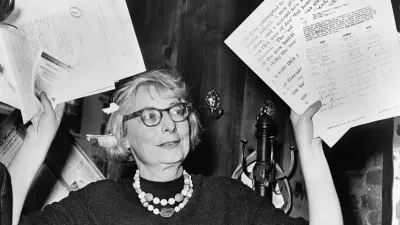Fifty years after Jane Jacobs published her seminal book, "her vision of urban change [has] won the day," says Inga Saffron. Though her vision of physical diversity has prevailed, "that vision is also giving us a new kind of sterility."
"Jacobs, whose The Death and Life of Great American Cities serves as the bible for city-lovers and modern planners, believed that blighted neighborhoods would regenerate organically if left to their own devices," writes Saffron. "But Jacobs’s predictions of multi-generational, multi-race, mixed-income kumbaya hasn’t turned out quite as she hoped."
What Jacobs called "unslumming," would see existing residents "fix up their homes as their economic circumstances improved over time," attracting a gradual influx of newcomers drawn to "the charms of these diverse, lived-in neighborhoods."
"Unfortunately," says Saffron, "that rarely happens. Today we know the process she described by another name entirely: It’s not unslumming. It’s gentrification, a word that doesn’t sound nearly as quaint or benign....Appealing as it sounds in theory, Jacobs’s picture of hard-working locals hammering and spackling their way to an unslummed paradise has proved more romanticized than real."
"It turns out that the old complaint against gentrification, that it drives out minorities, is far too simplistic. Instead, we should be worrying about a different concern: It hasn’t built the diversity that Jacobsian urbanists envisioned, and that cities need. Diversity, in all its forms, is the urban advantage; it’s what lured a suburb-raised generation to 19th century rowhouses in the first place. After all these years of trying to revive their old neighborhoods, what a shame if it turns out that American cities have birthed a new kind of monotony."
FULL STORY: The Real Problem with Gentrification

Planetizen Federal Action Tracker
A weekly monitor of how Trump’s orders and actions are impacting planners and planning in America.

Map: Where Senate Republicans Want to Sell Your Public Lands
For public land advocates, the Senate Republicans’ proposal to sell millions of acres of public land in the West is “the biggest fight of their careers.”

Restaurant Patios Were a Pandemic Win — Why Were They so Hard to Keep?
Social distancing requirements and changes in travel patterns prompted cities to pilot new uses for street and sidewalk space. Then it got complicated.

Platform Pilsner: Vancouver Transit Agency Releases... a Beer?
TransLink will receive a portion of every sale of the four-pack.

Toronto Weighs Cheaper Transit, Parking Hikes for Major Events
Special event rates would take effect during large festivals, sports games and concerts to ‘discourage driving, manage congestion and free up space for transit.”

Berlin to Consider Car-Free Zone Larger Than Manhattan
The area bound by the 22-mile Ringbahn would still allow 12 uses of a private automobile per year per person, and several other exemptions.
Urban Design for Planners 1: Software Tools
This six-course series explores essential urban design concepts using open source software and equips planners with the tools they need to participate fully in the urban design process.
Planning for Universal Design
Learn the tools for implementing Universal Design in planning regulations.
Heyer Gruel & Associates PA
JM Goldson LLC
Custer County Colorado
City of Camden Redevelopment Agency
City of Astoria
Transportation Research & Education Center (TREC) at Portland State University
Camden Redevelopment Agency
City of Claremont
Municipality of Princeton (NJ)



























